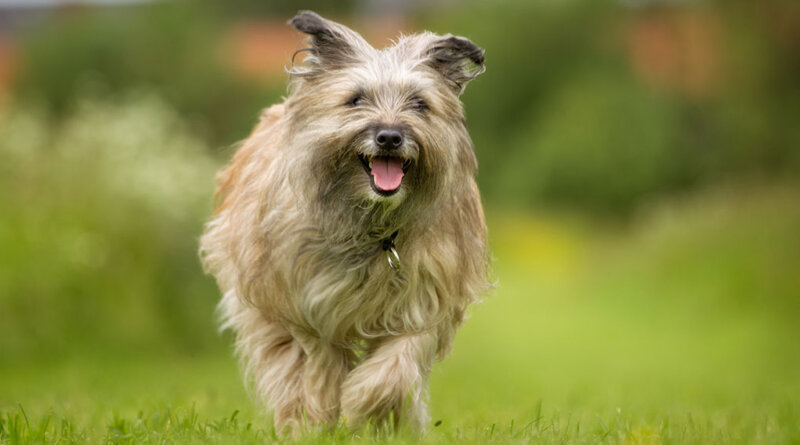Pyrenean Shepherd Dog Breed Profile – Top Dog Tips
Are you planning to adopt a new dog? Since you’re already here, let me present you with the Pyrenean Shepherd dog!
The Pyrenean Shepherd is a remarkable dog breed, also known as the Berger des Pyrénées.
All the way from France, this lean, agile, and versatile herding dog has been a loyal companion to shepherds for many years.
Pyrenean Shepherds are also energetic, smart, and dedicated. They might be one of the smallest sheepdogs in the world, but their characteristics will say otherwise.
This blog will discuss everything you’ll need to know about this captivating breed. We will explore its physical characteristics, temperament, health care, and more.
But before that, let’s talk about the Pyrenean Shepherd’s history.
Pyrenean Shepherd History
Originating from the Pyrenees Mountains, this breed was primarily developed as a herding dog. Pyrenean Shepherds love to assist shepherds in their daily tasks.
The exact origin of the Pyrenean Shepherd, or Pyr Sheps for short, is not well-documented. But many believe that they have descended from ancient herding dogs.
Over the years, the Pyrenean Shepherd played a great role in herding and management of livestock.
They are intelligent, agile, and have a strong work ethic, which allows them to navigate steep slopes, and terrains and do well in different weather conditions.
Their main tasks are gathering, driving, and guarding flocks. They also alert shepherds if there are potential threats or intruders.
The local shepherds highly regarded the breed’s herding abilities. They selectively bred the dogs based on their working skills and traits.
Over time, distinct varieties of the Pyrenean Shepherd emerged.
The Pyrenean Shepherd breed gained momentum in the early 20th century.
In 1926, the Société Centrale Canine or Central Canine Society officially recognized the breed, providing a much-needed boost to its recognition and preservation.
Since then, the breed’s popularity has steadily increased as a working dog and companion.
Today, the Pyrenean Shepherd is still a versatile herding dog in its native region.
Pyrenean Shepherd Physical Traits
So what does the Pyrenean Shepherd look like? Do they look cute? Are they athletically built?
The Pyrenean Shepherd is a small to medium-sized dog. Males typically stand between 15 and 21 inches at the shoulder, while females are slightly smaller.
The breed’s overall body length is slightly longer than its height, which gives a balance and proportional look.
Even though they have a small stature, the breed possesses a well-muscled and athletic body. They are known for their agility and endurance, after all.
Their muscular physique allows them to excel in various physical activities, such as herding, agility, and other dog sports.
The Pyrenean Shepherd comes in two distinct coat varieties: Rough-Faced and Smooth-Faced.
The Rough-Faced variety, also known as the long-haired variety, has a dense, medium to long, shaggy outer coat that protects against the elements.
On the other hand, the Smooth-Faced variety has a shorter, smooth coat. But both coats have a dense undercoat, which provides insulation in colder climates.
Pyr Sheps can come in a variety of coat colors and patterns. Colors include fawn, brindle, gray, black, and merle.
Pyrenean Shepherd Temperament
The Pyrenean Shepherd’s distinctive temperament sets it apart from other dog breeds.
Here are some key traits that characterize the temperament of the Pyrenean Shepherd:
Intelligence
These dogs are also known for their exceptional brain. With their sharp mind, they are very quick learners.
This gives them the ability to understand and respond to commands effectively.
Adaptability
Pyrenean Shepherds are also highly adaptable dogs. They can excel in different activities and training ventures.
Diligence
Bred as herding dogs, Pyr Sheps have a strong work ethic ingrained in their nature.
They are driven and diligent workers, dedicated to their tasks.
Owners of these dogs should provide them opportunities to engage their herding instincts or allow them to participate in dog sports.
Living with a Pyrenean Shepherd
Due to their high energy, they thrive on physical activities and mental stimulation. That’s why they are best partnered with owners that engage in vigorous activities.
This breed is not suited for an inactive lifestyle. But they will flourish in families where they can participate in running, hiking, agility, or playing interactive games.
Pyr Sheps can also adapt to different lifestyles, such as apartment living. But remember that you’ll have to cater to their exercise needs due to their high energy.
The Pyrenean Shepherd forms strong bonds with its family members and is known for its loyalty and protective nature.
However, they are often wary of strangers and can be reserved around unfamiliar people or environments.
Even though those traits make them good watchdogs, early socialization is crucial to ensure they’ll grow into well-rounded pups.
Training and Exercise
Just like with any dog breed, training and exercise are crucial. And as with the Pyrenean Shepherd, this dog is full of energy!
So the question is, are you up for the challenge?
This breed is highly intelligent and energetic. They thrive on mental and physical stimulation.
Pyrenean Shepherds respond best to positive reinforcement training methods. Use rewards such as treats, praise, and play to motivate and reinforce desired behaviors.
Don’t use harsh or punishment-based methods. You wouldn’t want to tarnish their trust and relationship with your pup!
As discussed above, early socialization is essential to this dog breed. Start socializing your Pyrenean Shepherd from a young age.
Introduce them to various people, animals, and environments to help them develop confidence and good manners.
Expose them to different situations, sounds, and stimuli to ensure they are well-adjusted and comfortable in various settings.
ALSO READ: The Puppy Socialization Checklist
Pyr Sheps are intelligent dogs that require mental stimulation. Mental stimulation can prevent boredom and potential behavior problems in the future.
Engage them in puzzle toys, interactive games, and training sessions that challenge their minds.
Activities like obedience training, agility, and nose work can provide mental stimulation while strengthening the bond between you and your dog.
Now, if you’re the type of person that loves to exercise, this might be the dog breed for you!
Pyrenean Shepherds are an active breed that requires regular and vigorous exercise.
Aim for at least one to two hours of daily exercise to help them burn off energy and stay physically fit.
Go for long walks, jogging, hiking, or playing fetch in a secure area. You can also make your bonding session with Fido this time to strengthen your relationship.
Pyrenean Shepherd Health Care
Generally, the Pyrenean Shepherd is a healthy dog breed. Their life expectancy is about 15 to 17 years!
But unfortunately, the Pyr Shep can be prone to illnesses like any other breed.
Owners should schedule regular visits to the veterinarian to keep their health in check.
Hip Dysplasia
Hip dysplasia is a genetic condition wherein the socket of the joint and ball becomes distorted.
Due to their large stature, their mass stresses their lower body areas, especially in their joints.
When diagnosed with hip dysplasia, it’s essential to keep their weight in the normal range and have them exercise with activities that promote joint therapy.
Veterinarians may prescribe medications for anti-inflammatory, pain relievers, and supplements.
Progressive Retinal Atrophy
Progressive Retinal Atrophy, or PRA, is another health condition the Pyr Shep is prone to.
This condition affects the rod and cone cells in the eyes, leading to blindness. Unfortunately, this disease can progress quickly from a year or two.
It is also a hereditary disease known to have no treatment yet. Having your dog’s eyes frequently checked is best advised to reduce the risk of PRA.
Epilepsy
Lastly, epilepsy is a condition that causes mild or severe seizures in dogs.
It can be genetic, caused by metabolic disorders, brain injuries, or tumors. However, the cause of idiopathic epilepsy is still unknown.
Veterinarians may administer anti-seizure, but it can only reduce the severity of the seizure.
Ensure your dog is checked immediately to provide the right medication for the disorder.
Patellar Luxation
Patellar Luxation occurs when the patella moves its alignment out of the femur. Similar to the conditions above.
Like the ones above, patellar luxation is a hereditary disorder in dogs.
This can range from high to low levels of luxation, and each requires different treatments.
Symptoms may include skipping and kicking off the leg. It’s best to contact the vet for treatments, therapies, or procedures to help your pooch with this condition.
If your Pyrenean Shepherd has been diagnosed with patellar luxation, it should never be bred anymore. It’s best not to bring these despairing conditions to their offspring.
Patent Ductus Arteriosus
Patent Ductus Arteiosus is a heart defect that happens when the ductus arteriosus does not close at birth.
This forces the left side of the heart to work harder in pumping blood with each heartbeat to meet the body’s demands.
Unfortunately, it will eventually lead to congestive heart failure. The signs may include difficulty in breathing, abnormal pulses, and a loud heart murmur.
Grooming
Grooming is also an essential part of caring for dogs. Luckily for you, grooming a Pyrenean Shepherd is relatively straightforward since they have a low-maintenance coat.
However, regular grooming is still necessary to keep their coat healthy and free from matting. Weekly brushing removes loose hair, prevents matting, and keeps the coat neat.
The Pyrenean Shepherd does not require frequent bathing unless they get dirty or have a strong odor. Aim to bathe them every two to three months or as needed.
Regular nail trimming is essential to prevent overgrowth, discomfort, and potential injuries. When trimming their nails, a good rule is never to let them touch the ground.
Regular brushing of your Pyrenean Shepherd’s teeth helps maintain good oral health and prevents dental issues.
Daily brushing is best recommended to avoid tartar buildup and remove bacteria lurking inside their mouths.
Frequently Asked Questions
Are Pyrenean shepherds good family dogs?
Yes, Pyrenean Shepherds can make excellent family dogs.
They can be great companions with proper socialization and training, as they do well with children.
These dogs are loving and protective. However, they may not be suitable for families with multiple pets as they can be bossy and have strong herding instincts.
Do Pyrenean shepherds have tails?
Yes, Pyrenean Shepherds have tails, but they are usually docked.
The natural tail length of Pyrenean Shepherds can vary, with some individuals having a full-length tail, while others may have a naturally short or bobbed tail.
What is good about a Pyrenean Shepherd?
A few things that stand out about the Pyrenean Shepherd are their intelligence and eagerness to learn.
On top of that, they are also protective and affectionate dogs.
Pyrenean Shepherd Dog Breed: Summary
The Pyrenean Shepherd is a lively and versatile herding dog from the Pyrenees Mountains in France.
Pyrenean Shepherd thrives in physical and mental activities. They have a deep passion for their work and family.
If you’re considering adopting a Pyrenean Shepherd puppy, remember they’ll need plenty of exercise and proper training.
Do you love to go on hikes? Or maybe a long jog? Well, this dog might be a match made in heaven.
Pyr Sheps are also affectionate companions who get along with their family members. Don’t worry! They get along great with children too.
RELATED READS










